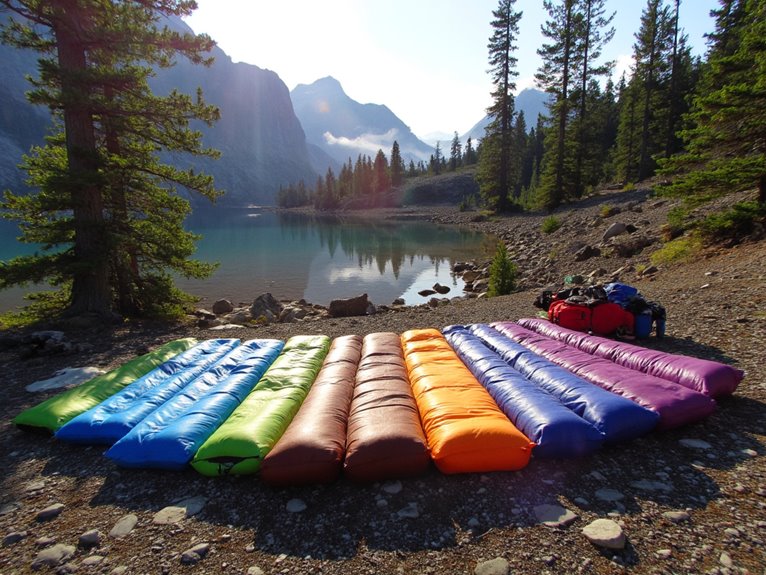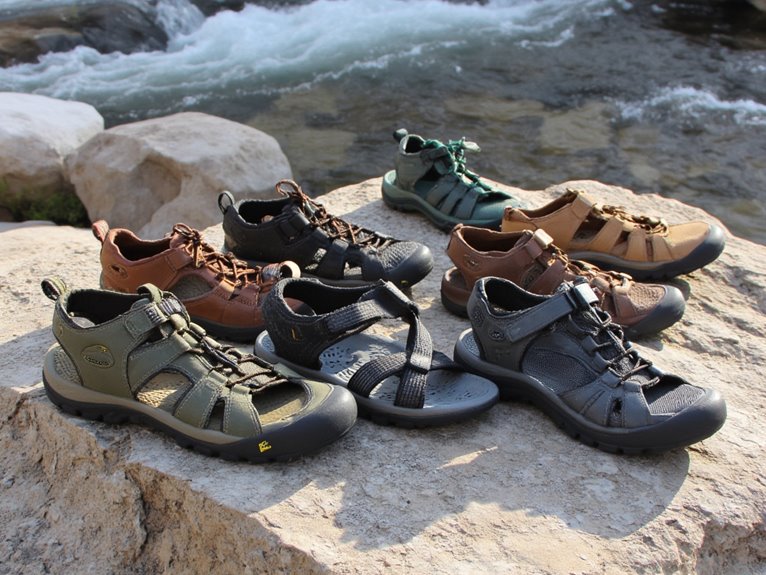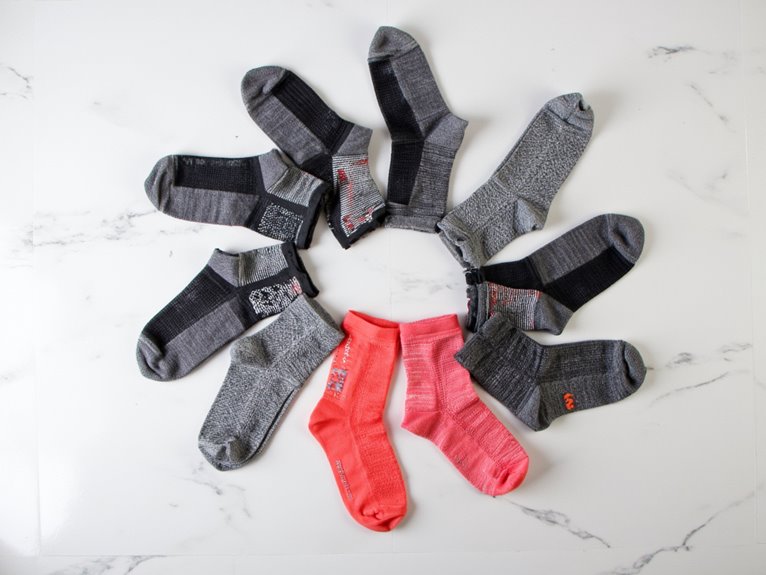10 Best Backpacking Sleeping Mats for Ultimate Comfort on the Trail
I’ve tested sleeping pads from the ultralight 14-ounce Therm-a-Rest Z Lite Original to the 8.1-pound Wevelel Memory Foam Pad across diverse conditions. Top performers include the ApolloAir with its exceptional 5.2 R-value and durable Hexagon Shield 40D nylon, the quick-inflating 78in pad with built-in foot pump, and the versatile Sea to Summit with 4.2 R-value for year-round use. Each pad balances weight, warmth, and comfort differently to match your specific trail demands.
We are supported by our audience. When you purchase through links on our site, we may earn an affiliate commission, at no extra cost for you. Learn more. Last update on 5th December 2025 / Images from Amazon Product Advertising API.
Notable Insights
- ApolloAir offers superior four-season warmth with 5.2 R-value while weighing only 17 ounces for ultralight backpacking.
- Built-in foot pumps on 78in and Yuzonc pads enable rapid 30-60 second inflation for quick trail setup.
- Sea to Summit provides year-round comfort with 4.2 R-value and durable 75D polyester construction for reliable performance.
- Wevelel Memory Foam delivers luxury comfort with 9.5 R-value but weighs 8.1 pounds, limiting use to car camping.
- Therm-a-Rest Z Lite weighs just 14 ounces and requires no inflation, eliminating puncture risks for reliable backcountry use.
Gear Doctors Ultralight Camping Sleeping Pad ApolloAir (5.2 R-Value)

The Gear Doctors Ultralight Camping Sleeping Pad ApolloAir stands out as the ideal choice for four-season backpackers who prioritize warmth without sacrificing pack weight. You’ll appreciate its exceptional 5.2 R-value that handles cold weather conditions effectively. This pad weighs just 17 ounces while supporting up to 250 pounds.
The inflated dimensions measure 72 x 21 x 3.2 inches, providing adequate sleeping space. You can pack it down to 8.5 x 3 inches using the trifold method. The Hexagon Shield 40D Nylon fabric with E-LAST coating delivers 2.5 times standard durability.
You’ll inflate it in five minutes using the included pump sack and 4-step anti-leak valve system.
Best For: Four-season backpackers and hikers who need reliable insulation in cold weather conditions while maintaining an ultralight pack weight.
Pros:
- Excellent 5.2 R-value provides superior warmth for four-season camping at only 17 ounces
- Durable Hexagon Shield 40D Nylon fabric with E-LAST coating is 2.5 times stronger than standard materials
- Quick 5-minute inflation with pump sack and anti-leak valve system, plus lifetime warranty
Cons:
- 21-inch width may feel narrow for larger users or those who move frequently during sleep
- Some noise during movement due to the nylon fabric material
- Higher price point compared to basic three-season sleeping pads
78in x 29in x 5in Camping Sleeping Pad with Built-in Foot Pump
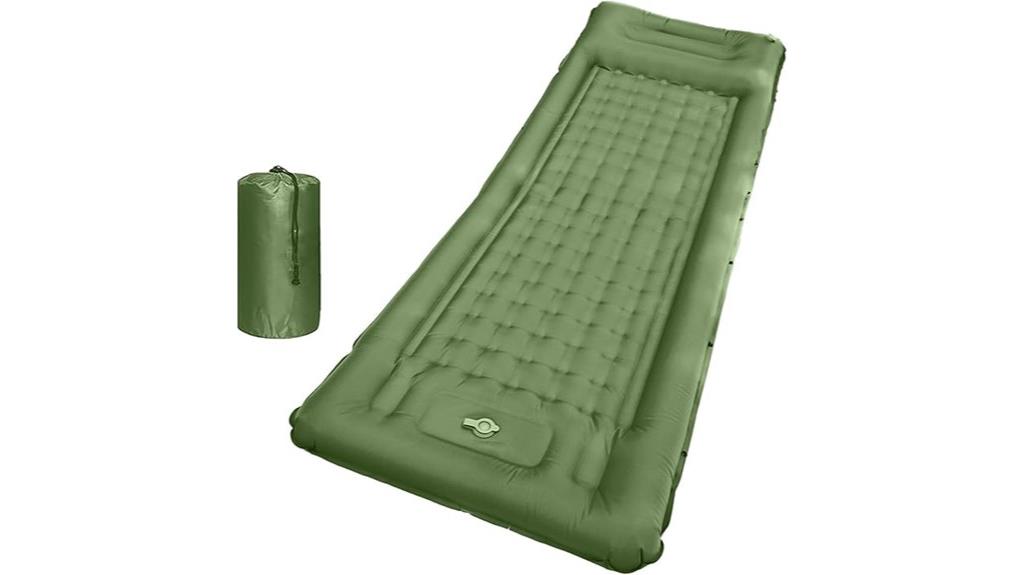
Ultralight backpackers who prioritize rapid setup and minimal pack weight will find this 78in x 29in x 5in camping sleeping pad delivers exceptional value through its built-in foot pump system. You’ll inflate this pad in 30-60 seconds without carrying additional equipment. The 2.38-pound weight and compact 4in x 4in x 11in folded dimensions won’t burden your pack.
The R-value of 5 provides excellent insulation for three-season use. You’ll appreciate the single-layer valve that deflates the pad instantly. However, expect noticeable crinkling sounds during movement. The 40D nylon with TPU coating offers reliable durability, while the attached pillow eliminates extra gear.
Best For: Ultralight backpackers and outdoor enthusiasts who need a lightweight, quick-inflating sleeping pad with excellent insulation for three-season camping and don’t mind some noise during movement.
Pros:
- Built-in foot pump allows 30-60 second inflation without carrying additional equipment
- Excellent R-value of 5 provides superior insulation for three-season use
- Ultralight at 2.38 pounds with compact 4in x 4in x 11in folded size for easy packing
Cons:
- Produces noticeable crinkling sounds when moving during sleep
- Some users report difficulty operating the foot pump system
- Limited to three-season use rather than four-season capability
Sea to Summit Camp Self-Inflating Foam Sleeping Mat for Camping and Backpacking

Backpackers seeking year-round comfort without sacrificing insulation will find the Sea to Summit Camp Self-Inflating Foam Sleeping Mat delivers exceptional performance across four seasons. The R-value of 4.2 provides reliable insulation for temperatures ranging from 1 to 5 degrees Celsius. You’ll appreciate the 75D polyester construction with TPU lamination that balances durability and weight at 2.4 pounds.
The rectangular 72 x 25 x 1.5-inch dimensions accommodate various sleeping positions while packing down to 8 x 13.5 inches. The multi-function valve enables fast inflation and controlled deflation. Users consistently rate this mat 4.5 out of 5 stars, praising its comfort and back support, though you’ll need extra breaths for ideal firmness.
Best For: Four-season backpackers and campers who prioritize comfortable sleep and reliable insulation in cold conditions while needing a mat that accommodates various sleeping positions.
Pros:
- Excellent 4.2 R-value provides reliable insulation for 4-season camping in temperatures from 1-5°C
- Rectangular shape accommodates multiple sleeping positions and can fit two people
- Durable 75D polyester construction with TPU lamination balances weight (2.4 lbs) and durability
Cons:
- Requires lengthy inflation time and additional manual breaths to achieve desired firmness
- May cause back pain after multiple nights of use according to some users
- Performance can be limited on harder surfaces compared to soft terrain
Memory Foam Sleeping Pad for Camping with Pillow

Memory foam technology transforms traditional camping sleep systems, and the Wevelel Memory Sleeping Pad exemplifies this advancement with its impressive 9.5 R-value rating that delivers superior insulation performance across all seasons. You’ll get 77 x 30 x 3.5 inches of sleeping space when inflated, with high-density 50D memory foam providing even weight distribution. The pad supports 800 pounds and features outdoor-grade 50D stretch knit fabric that’s breathable and tear-proof. Self-inflation occurs in 30 seconds through three valves, while the built-in foot pump lets you adjust firmness easily. At 8.1 pounds, it’s designed for car camping rather than ultralight backpacking adventures.
Best For: Car campers and casual outdoor enthusiasts who prioritize comfort and warmth over weight savings and don’t mind carrying an 8.1-pound sleeping pad.
Pros:
- Exceptional insulation with 9.5 R-value rating provides superior warmth retention for all-season camping
- Memory foam construction with even weight distribution offers luxury mattress-level comfort for side sleepers
- Quick 30-second self-inflation with built-in foot pump allows easy setup and firmness adjustment
Cons:
- At 8.1 pounds, significantly heavier than ultralight alternatives, making it impractical for backpacking
- Large dimensions (77 x 30 x 3.5 inches) may not fit in smaller tents or cramped camping spaces
- Higher price point compared to basic inflatable sleeping pads due to memory foam technology
Yuzonc Camping Sleeping Pad with Built-in Pillow & Foot Pump
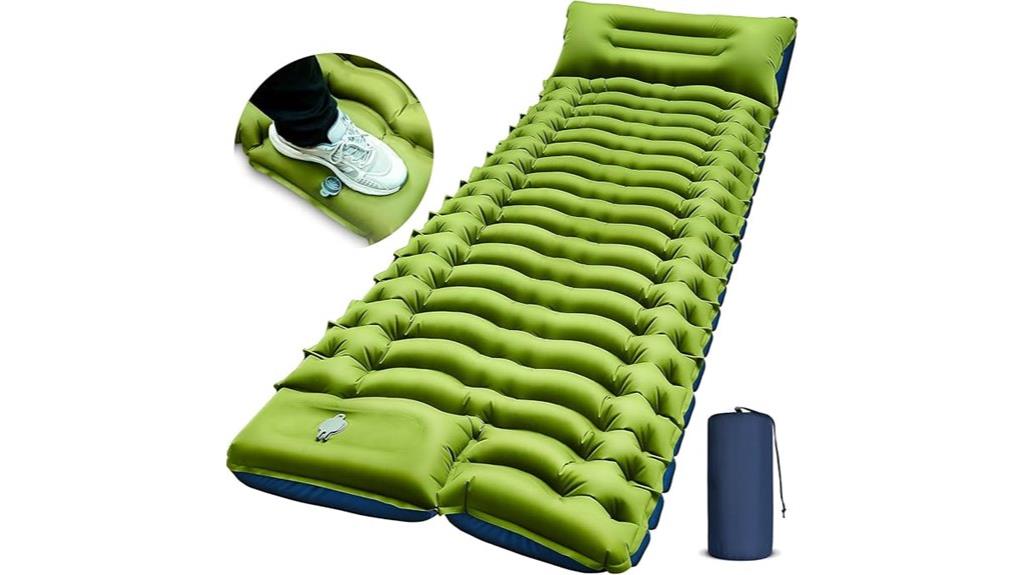
The Yuzonc Camping Sleeping Pad delivers exceptional value for outdoor enthusiasts who prioritize convenience without sacrificing comfort. You’ll appreciate the built-in foot pump that inflates this 78×27×3-inch pad in 30-60 seconds without external equipment. The innovative egg-shaped air cells provide superior support for your back and neck, while the integrated pillow eliminates extra gear.
This 1.5-pound pad supports up to 400 pounds despite its ultralight construction. The outdoor-grade 40D nylon exterior with TPU sealing resists tears and simplifies cleaning. You can connect two pads for twin-bed sleeping arrangements. The upgraded double-layer valve deflates the pad instantly for quick packing. While some users report size inconsistencies and reduced cold-weather insulation, the overall convenience makes this pad ideal for backpacking.
Best For: Backpackers and outdoor enthusiasts who want a lightweight, convenient sleeping solution with built-in inflation and pillow features for car camping and mild weather conditions.
Pros:
- Built-in foot pump inflates the pad in 30-60 seconds without requiring external equipment or mouth inflation
- Ultralight at 1.5 pounds with 400-pound weight capacity and integrated pillow reduces gear requirements
- Durable 40D nylon construction with TPU sealing resists tears and connects with another pad for twin-bed arrangements
Cons:
- Size inconsistencies reported by some users may affect fit and comfort expectations
- Reduced insulation performance in cold weather conditions limits cold-season camping use
- Variable inflation methods and experiences suggest potential quality control issues
Therm-a-Rest Z Lite Original Camping and Backpacking Sleeping Pad
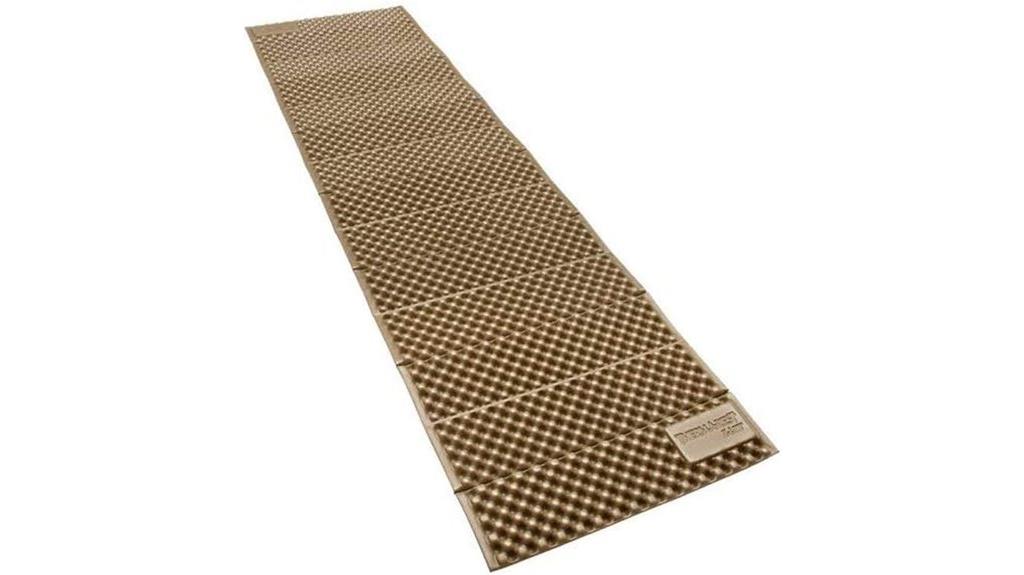
When durability and reliability matter more than plush comfort, the Therm-a-Rest Z Lite Original delivers uncompromising performance for budget-conscious backpackers. This closed-cell foam pad weighs just 14 ounces and measures 72 x 20 inches. It folds accordion-style to 20 x 5 x 5.5 inches for easy packing. The R-value of 1.7 provides adequate insulation for mild conditions. You’ll appreciate the puncture-proof design and water-resistant material that eliminates inflation worries. The dimpled surface retains heat while softer top foam enhances comfort. Users report reliable warmth down to 10°F, though you’ll sacrifice plushness for bulletproof dependability and lifetime warranty coverage.
Best For: Budget-conscious backpackers and campers who prioritize durability, reliability, and puncture-proof performance over plush comfort in mild weather conditions.
Pros:
- Extremely durable and puncture-proof closed-cell foam construction with lifetime warranty
- Lightweight at 14 ounces with compact accordion-style folding for easy packing
- No inflation required and water-resistant material eliminates concerns about leaks or moisture absorption
Cons:
- Limited comfort compared to inflatable pads with firm surface that may require sleep position adjustments
- R-value of 1.7 restricts use to mild conditions only, not suitable for cold weather camping
- Basic cushioning may be insufficient for side sleepers without additional padding
Foam Camping Pads for Sleeping, Waterproof Outdoor Sleeping Mat
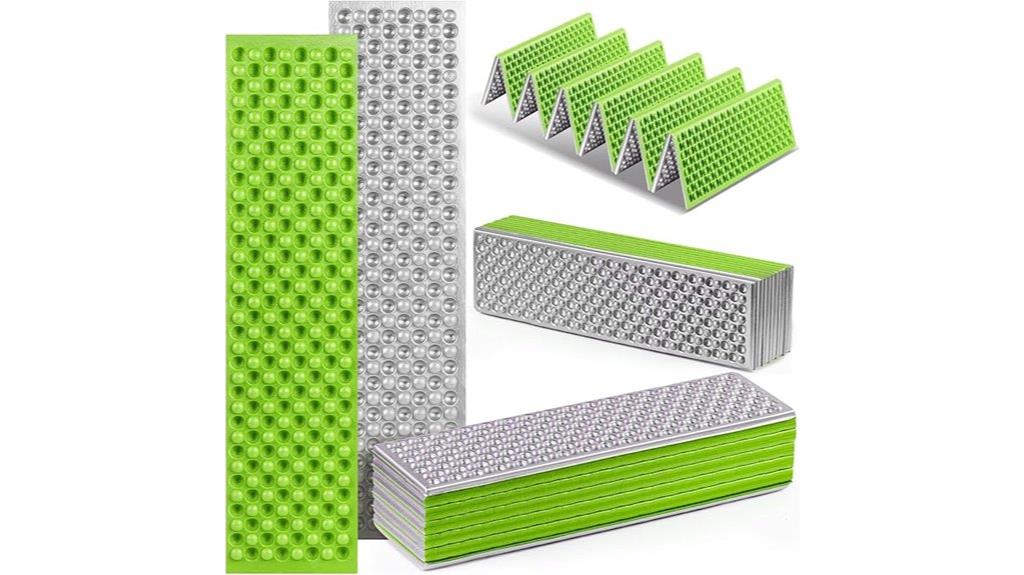
Foam camping pads excel for backpackers who prioritize reliability over luxury, since they can’t puncture like inflatable alternatives and maintain insulation even in freezing conditions. This waterproof sleeping mat measures 180*60*1.8cm when deployed and folds to 60*14*14cm for transport. You’ll carry just 455 grams while gaining an R-value of 2.1 for three-season protection.
The IXPE foam construction features aluminum backing that reflects body heat upward. This combination provides decent insulation without inflation mechanisms that fail in cold weather. You’ll find the ergonomic design supports key pressure points adequately, though larger users report insufficient cushioning on rocky terrain. At 4.6 stars from 156 reviews, it ranks seventh among foam camping mats for good reason.
Best For: Backpackers and outdoor enthusiasts who prioritize lightweight, puncture-proof gear and need reliable insulation in cold conditions over maximum comfort.
Pros:
- Puncture-proof foam construction that maintains insulation even in freezing temperatures unlike inflatable pads
- Extremely lightweight at 455 grams with compact folding design for easy transport during backpacking
- Waterproof IXPE material with aluminum backing provides effective heat reflection and moisture protection
Cons:
- Thin 1.8cm profile provides insufficient cushioning for larger users or on rocky, hard terrain
- Limited comfort compared to thicker sleeping pads, requiring additional padding on rough surfaces
- R-value of 2.1 may not provide adequate warmth for extreme cold weather camping
GearDoctors Ether Ultralight Sleeping Pad for Camping & Backpacking
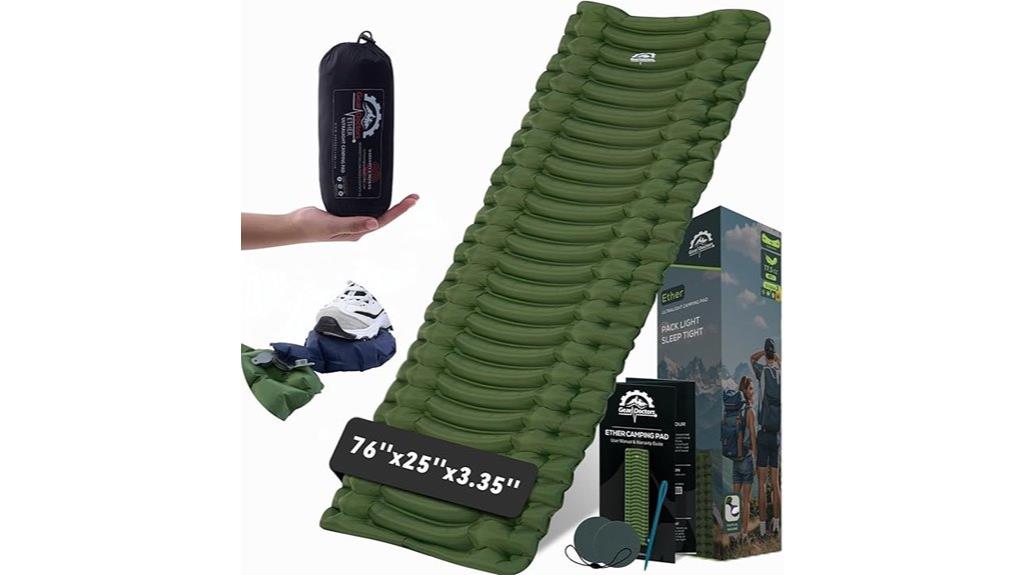
GearDoctors delivers exceptional portability with their Ether Ultralight Sleeping Pad, making it an ideal choice for weight-conscious backpackers who refuse to compromise on comfort. At 17.5 ounces, you’ll carry roughly the size of a water bottle (8.6″ x 3.1″). The pad inflates to 76″ x 25″ with ErgoCushion contours ranging from 3.35″ at edges to 2.36″ center depth, supporting up to 440 pounds.
You’ll inflate this pad in under 90 seconds using the detachable foot pump and Anti-Leak Valve System. The ergonomic U-shape design prevents rolling off during sleep. The 20-D Nylon construction with TPU coating provides durability, though the 2-R insulation value limits use to warmer seasons.
Best For: Weight-conscious backpackers and hikers who prioritize ultralight portability and quick setup for spring and summer camping trips.
Pros:
- Exceptional portability at just 17.5 oz with water bottle-sized packed dimensions (8.6″ x 3.1″)
- Quick 90-second inflation using included detachable foot pump with Anti-Leak Valve System
- Ergonomic U-shape design with ErgoCushion contours prevents rolling and accommodates side/back sleepers
Cons:
- Limited to warmer weather camping due to low 2-R insulation value
- Some users report slow air leaks and need for careful air pressure management
- Narrower width may feel restrictive for larger individuals or restless sleepers
Naturehike Insulated Inflatable Sleeping Pad (NKTR™ AIR)

The Naturehike Insulated Inflatable Sleeping Pad delivers exceptional cold-weather performance with its impressive R-value of 4.6, making it an ideal choice for winter backpackers and three-season adventurers who prioritize warmth without sacrificing packability. You’ll get reliable insulation for temperatures above -4°F through its eight-layer aluminum molded 3D system and NKTR AIR heat-reflective technology.
At 27 ounces, this pad strikes an excellent balance between weight and performance. The 3.2-inch thickness provides substantial cushioning, while the punching point design distributes pressure evenly for side and back sleepers. You can inflate it efficiently using the included bag with 4-5 squeezes through the patented dual-vent valve system.
Best For: Winter backpackers and three-season adventurers who need reliable cold-weather insulation down to -4°F while maintaining a lightweight, packable setup.
Pros:
- High R-value of 4.6 with eight-layer aluminum insulation provides excellent warmth for cold conditions
- Efficient inflation system with included bag requires only 4-5 squeezes through patented dual-vent valve
- Well-balanced design at 27oz with 3.2-inch thickness and pressure-distributing punching points for comfortable sleep
Cons:
- Storage bag is inadequately sized making repacking difficult and time-consuming
- TPU material may be noisier than fabric alternatives when moving during sleep
- At 27oz, it’s heavier than ultralight options for those prioritizing minimal pack weight
MEETPEAK Inflatable Camping Sleeping Pad with Built-in Pillow
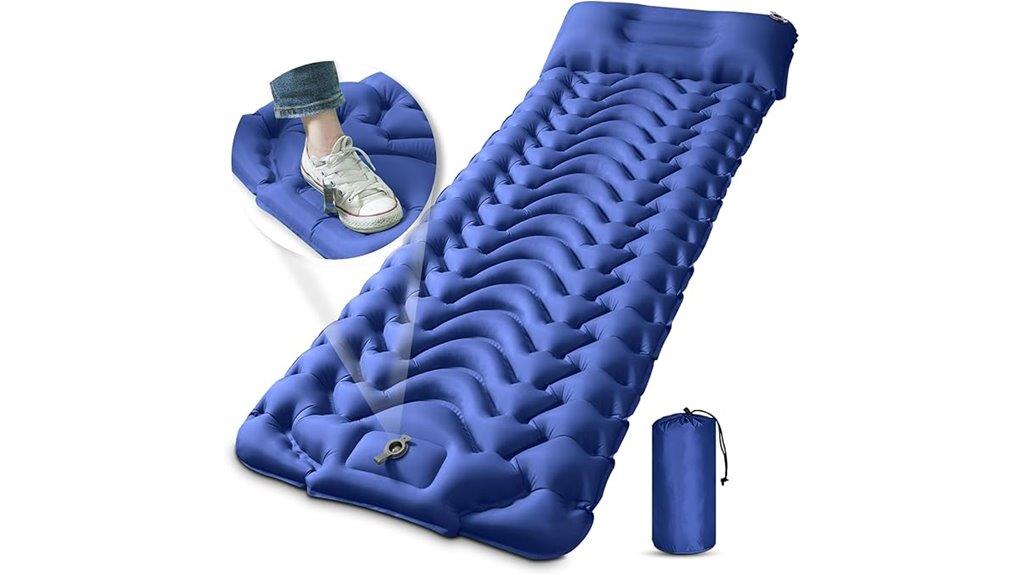
Weighing just 1.68 pounds, MEETPEAK’s inflatable sleeping pad delivers exceptional comfort for backpackers who refuse to compromise on sleep quality. The 78.74-inch by 27.6-inch pad features an extra-thick 3.2 to 4-inch profile with V-shaped design for ergonomic support. You’ll appreciate the built-in pillow that eliminates carrying separate gear.
The innovative foot press mechanism inflates the pad in 30 seconds and deflates in one second through a single valve. Made from 40d ripstop nylon with TPU coating, it supports 250 pounds while remaining puncture-resistant. When packed, it compresses to just 11.81 by 5.51 inches—roughly the size of a water bottle. Snap fasteners allow connecting two pads for double occupancy.
Best For: Backpackers and campers who prioritize lightweight gear without sacrificing sleep comfort and need quick setup with reliable support on various terrains.
Pros:
- Ultra-lightweight at 1.68 pounds with compact packing size comparable to a water bottle
- Rapid 30-second inflation using innovative foot press mechanism and 1-second deflation
- Extra-thick 3.2-4 inch profile with V-shaped ergonomic design and built-in pillow eliminates need for separate gear
Cons:
- Built-in pillow firmness may not suit all sleep preferences based on user feedback
- Some users report issues with inflation pump performance over time
- Instructions may have unclear translations affecting proper setup and usage
Factors to Consider When Choosing a Backpacking Sleeping Mat
I’ll walk you through five critical factors that determine whether a sleeping mat will serve you well on the trail. Your choice impacts everything from pack weight to sleep quality, so I recommend evaluating each factor against your specific hiking conditions. Weight and portability, R-value insulation ratings, size dimensions, material durability, and inflation methods each play distinct roles in overall performance.
Weight and Portability
Every ounce matters when you’re carrying your shelter system for miles across challenging terrain. I recommend targeting sleeping mats under 2 pounds for ultralight performance. Quality inflatable pads in the 1–2 pound range deliver excellent strength-to-weight ratios using 30D or 40D nylon materials.
Compactness proves equally critical. The best mats compress to water bottle dimensions or smaller, typically under 8 inches in height and 3–4 inches in diameter. This compact profile maximizes backpack space efficiency.
Weight directly impacts your hiking endurance and overall experience. Each pound saved on your sleeping mat allows you to carry more essential gear or simply reduces fatigue during long trail days. Modern inflatable designs achieve remarkable durability while maintaining ultralight characteristics, making them ideal for extended backpacking expeditions where every gram counts.
R-Value and Insulation
Beyond weight considerations, your sleeping mat’s R-Value determines whether you’ll stay warm or wake up shivering on cold ground. The R-Value measures thermal resistance—your mat’s ability to block heat transfer from your body to the earth below.
For three-season camping, I recommend R-Values between 2-4. Winter conditions demand R-Values of 4.6 or higher to maintain comfort below freezing. Four-season mats typically rate 5+ for extreme cold exposure.
Different construction methods affect insulation performance. Closed-cell foam provides consistent R-Values but adds bulk. Inflatable mats use internal baffles and synthetic fill for higher ratings with less weight. Self-inflating models combine both technologies.
Match your R-Value to expected temperatures. Insufficient insulation means heat loss regardless of your sleeping bag’s rating.
Size and Dimensions
When selecting a sleeping mat’s dimensions, you’re balancing comfort against pack weight and space constraints. Standard inflated dimensions span 72 to 78 inches in length and 20 to 30 inches in width. These measurements accommodate most sleeper sizes while maintaining reasonable portability.
Packed dimensions matter equally. Quality mats compress to 6-12 inches in height and 3-5.5 inches in diameter. This compression ratio directly impacts your pack’s available space for other essential gear.
Weight becomes critical for long-distance hiking. Ultralight options weigh 1-2.5 pounds, representing significant savings over heavier alternatives. Thickness ranges from 2-5 inches, affecting ground insulation and comfort on uneven terrain.
Don’t overlook weight capacity ratings. Most mats support 250-800 pounds, ensuring structural integrity throughout your trip. Choose dimensions that match your body size while considering your pack’s weight and volume limitations.
Material and Durability
Your sleeping mat’s material composition determines how well it’ll survive the rigors of backcountry use and repeated packing cycles. I recommend 40D nylon with TPU coating for superior tear resistance and water protection compared to basic fabrics. Foam pads using IXPE material with aluminum film backing offer excellent puncture resistance for rocky terrain.
For inflatable mats, look for reinforced 20D nylon or 75D polyester construction. These materials balance durability with lightweight portability. Thermoform sealing prevents air leaks during temperature fluctuations and extended use.
High R-value materials above 4.0 indicate both thermal efficiency and structural robustness for multi-season conditions. These enhanced materials withstand repeated compression cycles while maintaining insulation properties. Quality construction materials directly correlate with gear longevity and consistent performance across diverse trail environments.
Inflation and Setup
How quickly you can inflate your sleeping mat directly impacts your campsite efficiency and energy conservation after long hiking days. Built-in foot pumps deliver the fastest inflation, reaching full firmness in 30-60 seconds with minimal effort. These systems outperform manual methods that require multiple breaths or pump squeezes.
Anti-leak valve systems provide one-second deflation capabilities while maintaining secure air retention during use. Cold temperatures increase inflation time and effort requirements across all pump types. You’ll need to adjust air pressure throughout the night, particularly if you’re a side sleeper requiring firmer support.
Compact designs pack down to water bottle dimensions without compromising inflation speed. I recommend testing your mat’s pressure requirements before trips, as proper initial inflation prevents comfort issues and guarantees superior performance on varied terrain.
Comfort and Support
Everything about your backcountry sleep quality hinges on selecting a mat that balances thermal performance with physical comfort. I recommend prioritizing R-values between 1.7 for mild conditions and 9+ for extreme cold weather camping.
Thickness directly impacts comfort levels. Mats ranging from 3.2 to 5 inches provide superior cushioning over rocky terrain, while thinner options sacrifice comfort for portability. I’ve found that high-density memory foam and plush nylon materials offer exceptional body contouring and softer sleeping surfaces.
Ergonomic features matter considerably. Look for integrated pillows and contouring designs that reduce pressure points, especially if you’re a side sleeper. Advanced air cell designs distribute weight evenly across the mat’s surface, ensuring stability on uneven ground while maintaining consistent support throughout the night.
Pack Size Storage
Pack size becomes critical when every cubic inch of backpack space counts toward your hiking efficiency. I recommend targeting sleeping mats that compress to 3-4 inches in diameter and 8-12 inches in height when rolled. The most portable options pack down to approximately 8.5 inches x 3 inches, while anything exceeding 10 inches in length becomes cumbersome.
Weight matters equally. I look for ultralight designs weighing 1-2.5 pounds that maintain comfort without adding bulk. The best compact sleeping pads fold into shapes comparable to a water bottle, maximizing packing efficiency.
Storage compatibility with your backpack is vital. Your sleeping pad must fit securely alongside other gear without exceeding typical pack compartment dimensions. This guarantees balanced weight distribution and prevents awkward external attachments that can snag on trail obstacles.
On a final note
You’ve now seen the top-performing sleeping mats that’ll transform your backcountry sleep quality. Each model offers distinct advantages: ultralight construction, superior insulation values, or integrated comfort features. I’ve provided the technical specifications you need to match your specific requirements. Consider your typical camping conditions, weight tolerance, and comfort priorities. The right sleeping mat isn’t just gear—it’s your foundation for restorative sleep that powers tomorrow’s adventures.

